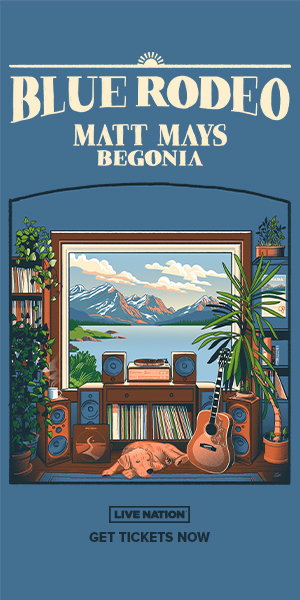Iceland Still Packed With Musical Choices, Even Without Festival
COVID means Iceland Airwaves was postponed again the year but Reykjavik still rocked on a recent visit.

REYKJAVIK — Legendary music festival Iceland Airwaves was postponed again this year because of COVID, but a recent visit to this most northern of capital cities is a music-soaked experience of new sensations in a place that’s surprisingly close yet feels so far away.
Touring Reykjavik With Siggy Baldursson
It helps that my tour guide used to call Björk his bandmate, though many of the charms of this city on the edge of the Arctic Circle are evident to even the most unpolished traveller.
But walking the mostly pedestrian-friendly downtown streets of Reykjavik with former The Sugarcubes drummer, Sigtryggur Baldursson — Siggy to his friends, which everyone quickly becomes — is an anecdote-fueled avalanche of insights. These are keys that unlock secrets — and punchlines — hidden behind the doorways and wind-resistant walls of a city where history is not just a flavour but a constant companion.
Watch The Sugarcubes’ music video for Cold Sweat
The only downside of touring with Siggy is the regular interruptions for greeting friends or fans.
“I’m a semi-celebrity,” Siggy modestly musters by way of apology for the interruptions. In addition to being a key member of the band that introduced Björk and Icelandic music to the world, Siggy has hosted a music show on national TV and regularly sits in with the country’s best emerging and established acts.
Touring Reykjavik also comes with a gnawing feeling that this city is just the tip of Iceland’s magic. “Damn, if this place is so weird and wonderful, what am I missing outside of town, beyond those magical, misty, snow-covered mountains?” I think to myself. “Shouldn’t I double down on adventure in search of vikings, volcanoes, whale skeletons and trolls?”
The Northern Lights
And always, the Northern Lights. If a taxi driver can be coaxed to talk, they speak of the Northern Lights the way cabbies in Vancouver speak of sunny days: “You should have been here yesterday, it was beautiful.”
Icelanders discuss tourists and the Northern Lights with the same bemusement Canadians muster for Americans driving into Canada in July with snow skis strapped to their cars and dreams of seeing igloos.
Tourists come to Iceland expecting to see the Northern Lights with the same reliability of seeing an animal at the zoo.
“They think we can just flip a switch and they turn on overhead,” says someone across the table from me at Hlemmur Mathöl, an old bus terminal turned upscale food hall when I ask about the lights. “It’s not like opening a sun roof and, suddenly, there they are.
“When the northern lights are out, no one has to tell you.”
I am then assured that the Saturday just before I arrived was indeed a magnificent night for the Lights — with the photographic evidence on their smart phone to prove it. I find myself spending the rest of the week hoping for nights filled with clear skies and “solar storms” overhead, though thoughts of raging solar punch-outs are somewhat spooky in a place that feels barely strapped to Earth.
The Imagine Peace Tower
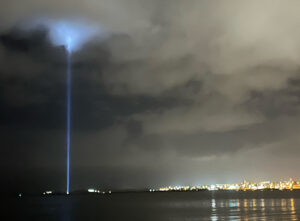 The Icelandic light show I do catch is the Imagine Peace Tower, an art — and inspiration — installation created by Yoko Ono, with the support of Icelandic governments. It honours Ono’s and late husband John Lennon’s commitment to the peace movement. The powerful “peace beam” is lit every year on Oct. 9, Lennon’s birthday, for two months on Videy, an island across Reykjavik harbour.
The Icelandic light show I do catch is the Imagine Peace Tower, an art — and inspiration — installation created by Yoko Ono, with the support of Icelandic governments. It honours Ono’s and late husband John Lennon’s commitment to the peace movement. The powerful “peace beam” is lit every year on Oct. 9, Lennon’s birthday, for two months on Videy, an island across Reykjavik harbour.
Its powerful beam slashes up and into the night sky like Thor’s hammer, cutting through the clouds and sending an SOS to the gods as we sit poised on what very much feels like the edge of the universe. There’s a poetic vulnerability to this bare and beautiful place, where the landscape literally boils and spews and eternity never feels that far away.
You can hear it in Icelandic music: ever-present shadows and darkness combined with precious sunlight that is welcomed and hungrily consumed.
Talk of climate change disaster, in the very days of the Blah Blah Blah Summit (COP26) in Glasgow, feels all the more real and imminent when the “melting ice caps of Greenland” are, you know, right over there and we’re all gathered on the shore of a tiny island. We’re as close to the most ironically named place on Earth as Toronto is to Kingston, twice as far as Vancouver is to Whistler.
There’s even at least one CSI-type crime show on Icelandic TV, Thin Ice, in which the bad guy is basically climate change.
Maybe Ono’s Peace Tower is some sort of eco bat-signal to extra-terrestrials, an emergency flare urging beings of higher intelligence to come save us from our impending eco-disaster.
Locals seem fond of the Peace Tower — no grumbling or Ono-bashing. Some even share stories of sightings of Lennon’s muse and their son Sean, who come most years for the annual lighting ceremony, though COVID has kept them away the last two.
I’m assured by locals that she and Sean are comped one of the finest hotel suites in Reykjavik whenever they visit.
“Once, I came out of the cinema and there she was, just sitting in a wheelchair waiting for her driver,” I’m told as a group of us explore an artist’s studio and others nod and mutter similar experiences. Reykjavik is small — not too small, just pleasantly small — and it’s easy to think that sooner or later you’d bump into anybody you wanted to in town.
I am basically counting on meeting Björk totally at random while I’m here and will be disappointed if this supposed inevitability doesn’t take place.
The Hallgrimskirkja Cathedral
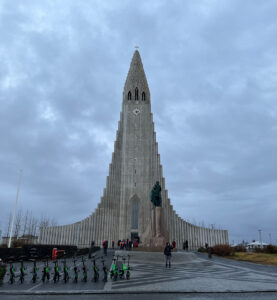 After a late afternoon visit to another cool, shared artists’ workspace around the corner from brutal and beautiful, Soviet-esque Hallgrimskirkja cathedral — one of the tallest buildings in this high-rise-free city — it’s suggested we drop by a fragrance and essential oils shop.
After a late afternoon visit to another cool, shared artists’ workspace around the corner from brutal and beautiful, Soviet-esque Hallgrimskirkja cathedral — one of the tallest buildings in this high-rise-free city — it’s suggested we drop by a fragrance and essential oils shop.
Fischersund, located closer to the harbour, is owned and operated by Sigur Rós lead singer, Jónsi Birgisson, and his extended family, including his sisters — one of whom is actually named Sigurrós — and father. (I randomly saw some Sigur Rós members jamming the night before at a modern dance performance in the lobby of the national theatre.)
I am convinced Icelanders savour scent as much as sunlight, both made scarce by winter. Fragrant herbs and oils are equally present in Icelandic cooking and spa experiences, and stepping into Birgisson’s cottage-like store, I feel like I am entering a sacred place: a cathedral to scent rather than sun.
 Birgisson’s sister, Lilja Birgisdóttir, quietly greets us, dressed in a white button-up collared shirt with a dark sweater — attire I imagine an Icelandic primary school teacher might wear. We are certainly receiving instruction tonight as Birgisdóttir patiently explains the deeper thinking behind the store while ambient music created by her brother plays through the discreet sound system.
Birgisson’s sister, Lilja Birgisdóttir, quietly greets us, dressed in a white button-up collared shirt with a dark sweater — attire I imagine an Icelandic primary school teacher might wear. We are certainly receiving instruction tonight as Birgisdóttir patiently explains the deeper thinking behind the store while ambient music created by her brother plays through the discreet sound system.
She pours us all a delicious, herb- and alcohol-infused liqueur to sip as we learn about scents. She explains that she will read words penned by her brother as we experience each scent, every one receiving its own “poem” for the occasion (listen to the reading below).
She then dutifully sprays our wrists with a gentle mist, encourages us to close our eyes and listen. And Birgisson’s somewhat random words make sense as images of snowy mittens, whale carcasses and pine boughs are shared, all somehow fully evoked because of the scents.
THE SHOWS
A stripped-down Icelandic Airwaves means no city-wide showcases but, on a recent Saturday night, at least three venues were hopping with multi-artists offerings that were also live streamed. I hit two classy joints and a good ole punk-rock bar.
Idnó
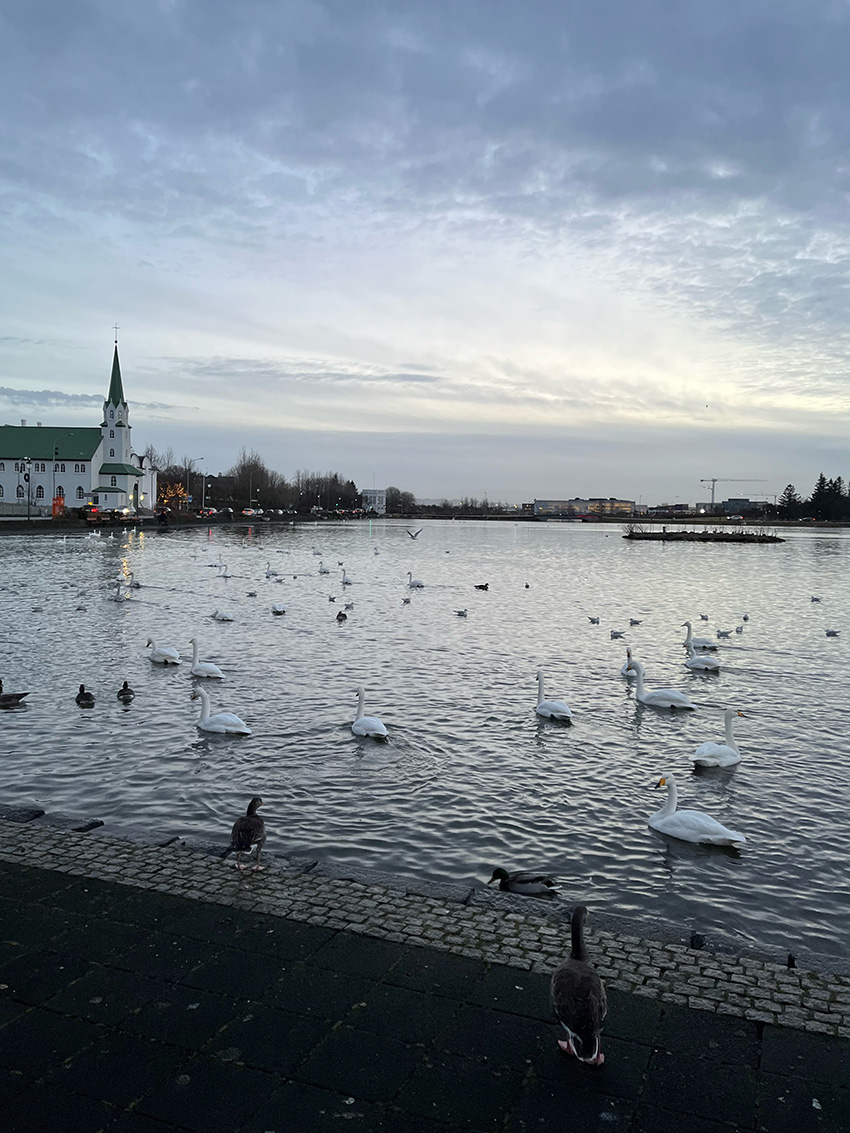 Idnó is a beautiful refurbished, old “cultural” building right downtown on the edge of Tjörnin, “City Pond”, an adorable, mellow body of water around the corner from “where Björk used to live.” It’s easy to see where she got inspiration for her legendary “Swan Dress,” the beautiful birds seemingly almost overflowing this splash of water about the size of 10 soccer fields.
Idnó is a beautiful refurbished, old “cultural” building right downtown on the edge of Tjörnin, “City Pond”, an adorable, mellow body of water around the corner from “where Björk used to live.” It’s easy to see where she got inspiration for her legendary “Swan Dress,” the beautiful birds seemingly almost overflowing this splash of water about the size of 10 soccer fields.
Believing “beats are the international language,” I’m eager to check out hip-hop acts and see two really good ones here.
Aron Can — Aron Can was born in Reykjavik and grew up working in his Turkish father’s kebab resto in town. With movie-star good looks, Can is a compelling force as he prowls the stage dropping gentle rhymes that have a Post Malone vibe. The crowd quickly embraces his appealing, upbeat energy.
Red Riot — Red Riot is a new, dance-powered collaboration between Icelandic pop singer Hildur (Hildur Stefánsdóttir) and rapper Cell 7 (Ragna Kjartansdóttir) that seems to spit out potential hits. There’s a pop-powered party vibe to songs that get their edge from Cell7.
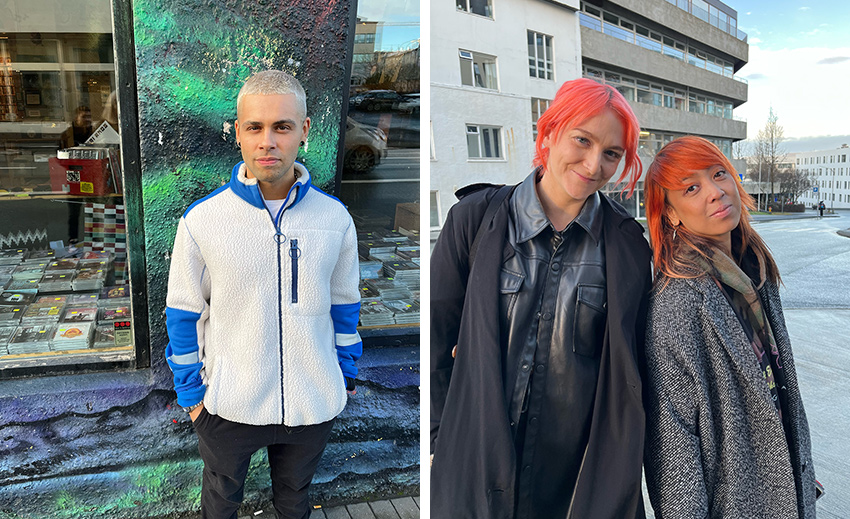
Aron Can (left), Red Riot (right) — Hildur (left) and Cell7.
Gaukurinn
Around the corner and up some stairs, Gaukurinn has that punk-rock-friendly vibe where (sings) “nobody knows your name,” and nobody gives a fuck. The floors are sticky, the air is heavy and, just like winter shows in Canada, everybody wants to figure out where to stick their coats. Just like home, fluffy jackets, scarves and more get jammed between monitor speakers and riser skirts at the edge of the stage.
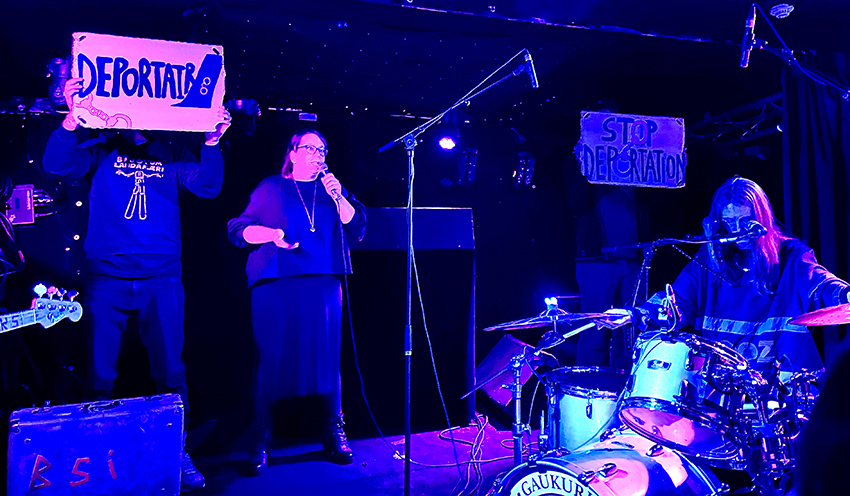
BSÍ — A small banner hanging from an onstage speaker declares “Refugees Welcome” and offers a clue that this band has something to say. Drummer Sigurlaug Thorarensen barks out vocals into a dial phone receiver microphone while her partner, Julius Rothlaender carries the rest of the musical load on bass and synthesizers that he plays with his stockinged feet.
Singing in English and Icelandic, it’s clear a bunch of things are pissing off BSÍ — including the festival and its main sponsor. Towards the end of the set, three pals walk out on stage, two carrying signs and one carrying a manifesto. One sign declares “Stop Deportation” while another (which looks a lot like festival sponsor Iceland Air’s logo) features the words “Deportair.” As the manifesto is read, we are told of the airline’s complicity in “repatriating” refuges away from Iceland.
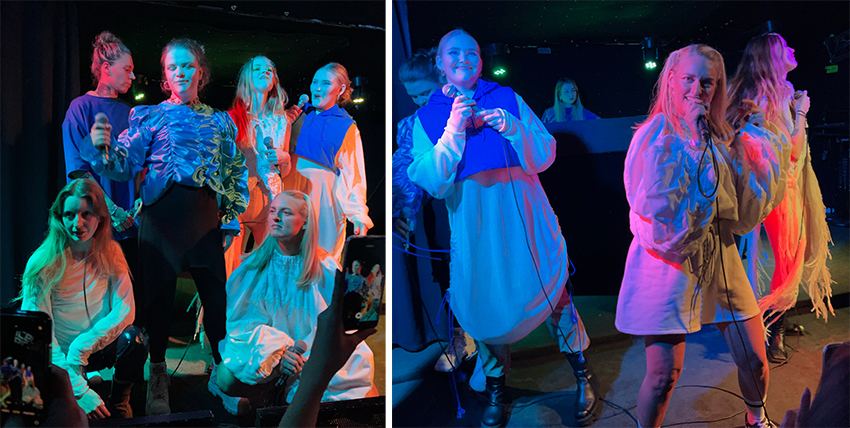
Daughters of Reykjavik — The attitude is as heavy as the air when a seemingly endless supply of “daughters” make their way onto the tiny stage, each with their own apparently limitless load of “What are you going to do about it?” energy.
This boundless bevy of blondes — even the DJ looks like she could be an ABBA-daughter — have the talent to match the ’tude with a show so compellingly kick-ass they basically dare you to look away.
Trading the lead from singer to singer, the “daughters” lean into the crowd and hop on monitor speakers, bubbling and boiling like one of the about-to-burst volcanoes just outside town.
Their incredible track Hot Milf Summer is even better live than in the YouTube video of the song, which carries a warning, garnered perhaps because the vid features band members blasting mother’s milk from their boobs like lasers. Turns out YouTube censors are lactose intolerant.
Gamla bíó
FLOTT (singer Vigdís Hafliðadóttir pictured) — Sporting matching track suits, this upbeat pop quintet has had a few chart-topping hits in Iceland. Proudly performing exclusively in Icelandic — “Maybe in Swedish, Swedish is cool” — their up-tempo, synth-fuelled fun has a winning ’80s vibe that gets the crowd happily dancing along.
THE STUDIOS
The Icelandic government really, really wants you to record albums or soundtracks in Iceland. No, really! They rebate 25 per cent of all costs incurred while recording here — not just studio time and staffing but all travel costs and even the fees or salaries of staff you bring from Canada. “Why not stop off in Iceland on your way to Europe?” is a regular refrain.
My hosts show me three studios while I’m here, and each would elicit twinkles in any performer’s eye — we have to drive across a lava field to get to one. Actually, lava fields are everywhere — oh that’s what that black rock is — so, not really that unique but still very cool.
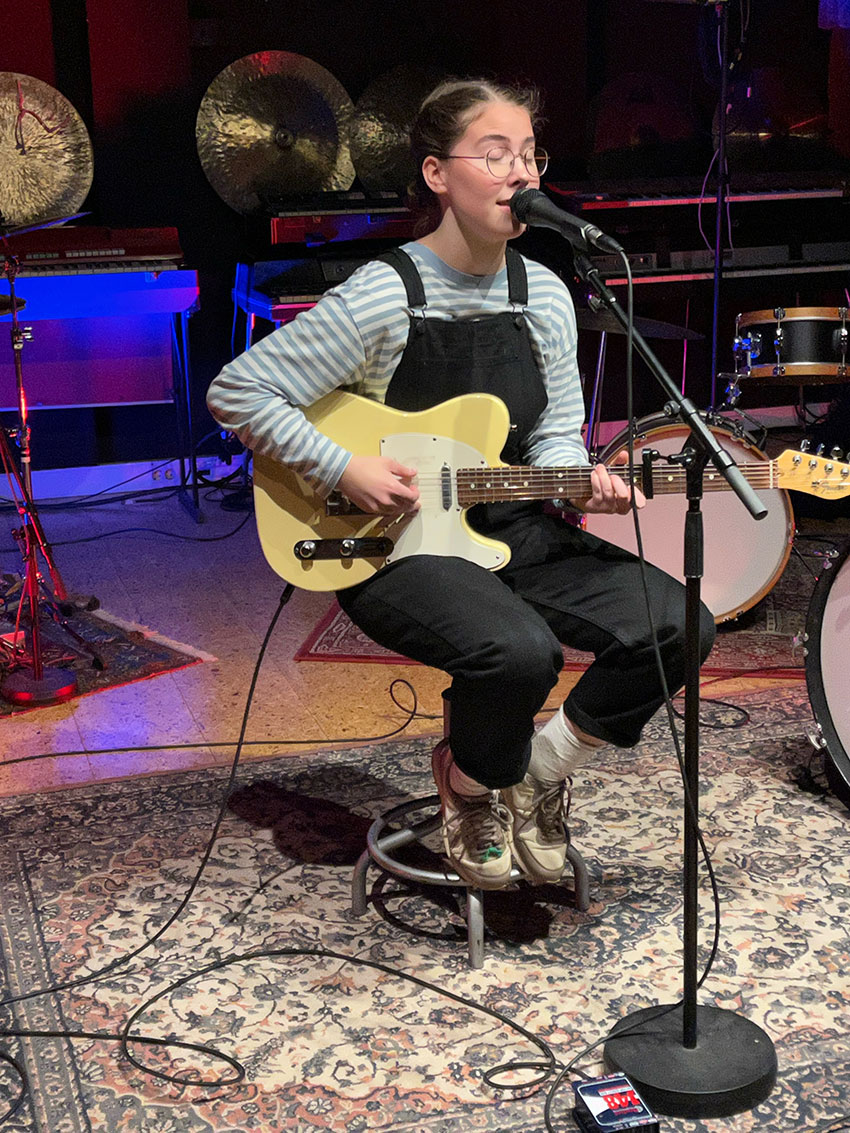 Our first stop is Hljódriti, which actually has the lava rock on the studio wall — and many a hapless musician has wasted time searching for hash alleged to be hidden in it. (I didn’t find any.) Built in 1972 and designed by John Storyk of Electric Ladyland fame, it’s the oldest studio in Iceland.
Our first stop is Hljódriti, which actually has the lava rock on the studio wall — and many a hapless musician has wasted time searching for hash alleged to be hidden in it. (I didn’t find any.) Built in 1972 and designed by John Storyk of Electric Ladyland fame, it’s the oldest studio in Iceland.
It’s a cozy place with lots of wood — amid the lava — and vintage instruments and microphones. It ends up being the perfect location to hear a brief set by young Icelandic singer-songwriter Arny Margret, who performs heartfelt tracks in English supported by tastefully picked guitar and is produced by the studio owner.
(Margret plays a free show at Toronto’s El Mocambo, Thurs., Dec. 2, as part of the Taste of Iceland cultural program in the city that weekend.)
 Our visit to the Greenhouse Studios — a bright, roomy space tucked into the edge of a bedroom community outside Reykjavik — is like coming home for Siggy, who has used the studio to record. We even find a piece of abandoned Sugarcubes gear while we are there.
Our visit to the Greenhouse Studios — a bright, roomy space tucked into the edge of a bedroom community outside Reykjavik — is like coming home for Siggy, who has used the studio to record. We even find a piece of abandoned Sugarcubes gear while we are there.
Björk recorded the Dancer in the Dark soundtrack as well as her Vespertine and Medúlla albums here, and it’s easy to see why the top act in town would choose this inviting locale.
Our “studio” tour wraps up with a visit back downtown to the Harpa Concert Hall, on the edge of the water, and that is being promoted as a recording venue. It’s the kind of awesome structure that often requires public money to build. Started just before the financial crisis hit in 2008, it’s a magnificent collision of shapes and colours, retro-modern invoking mid-century architectural largess of things like Expo 67 as well as, duh, 1970s Scandinavian design.
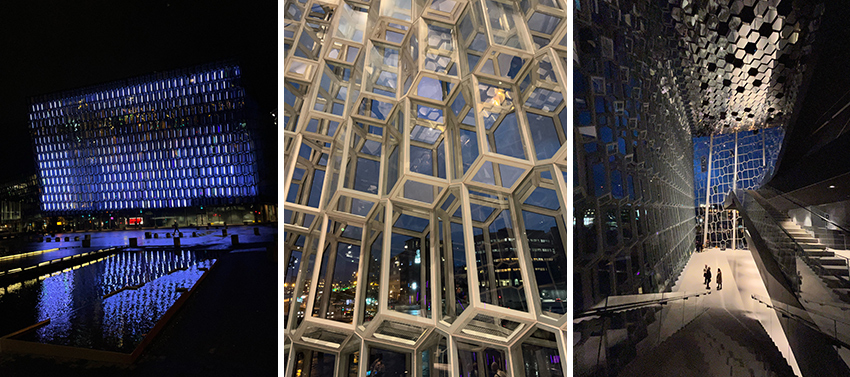
The largest concert hall in the multi-roomed building features walls, parts of which can be operated like sound bellows. It’s a beautiful structure filled with stairways and multiple performance spaces, and costumed opera singers seem to routinely pop out of doorways to bounce down stairs like buoys bobbing in the harbour. Members of Sigur Rós are providing the live soundtrack for a group of modern dancers performing in the lobby as I leave.
THE SPA
Iceland’s incredible geothermal bounty is felt everywhere, the hotel is heated with radiators, natch, and they have been washing their clothes in hot water here for 1,000 years — in the stream.
And all manner of geothermal bathing experience is available, from neighbourhood baths to posh spas and everything in between. If you’re lucky, you might stumble on geo-thrills in the wilds, outside of the city.
Siggy makes sure I cap my Icelandic stay with a visit to Sky Lagoon. Its massive geothermal, heated pools, formed by lava rock, look out on Reykjavik’s harbour and are the perfect way to end a week spent in clubs and recording studios.
We ease into a super-mellow mood, steam forming on our plastic glasses filled with Viking Beer, sweat happily sliding down our faces, even more steam rising from the pool. Siggy assures me that he paddles his kayak from his nearby home to a point just off shore from the spa, where he reliably fishes for cod.
We eventually coax ourselves to move on and plunge into a pool of freezing water followed by a sauna, a self-scrub with minerals — mostly salt — and then a steam room finale.
I will leave Iceland about as reluctantly as I leave the geothermal baths and assure myself I will be returning to both sometime soon.
And where the hell was Björk? Next time.


